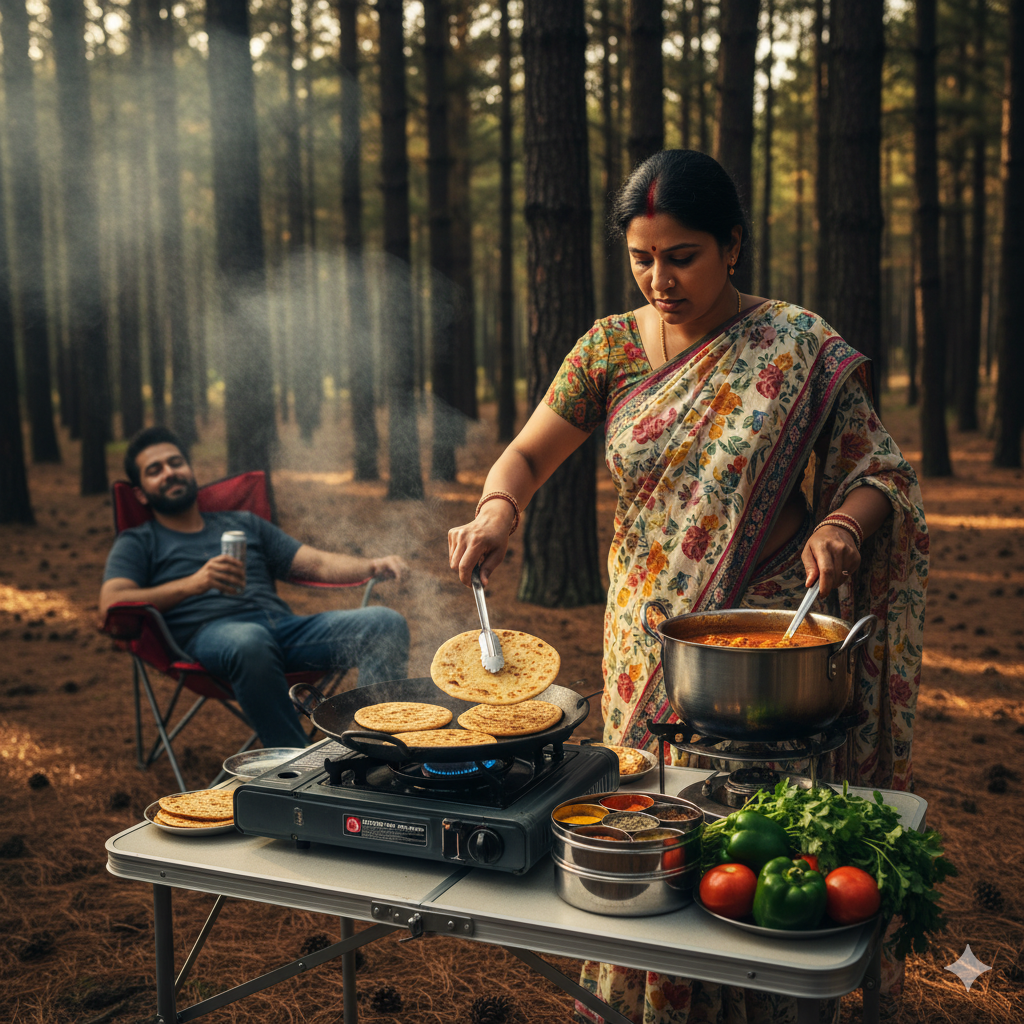There are few spectacles in this age of mechanical excess so instructive as the modern desi family gone camping. They arrive not as pilgrims into the wilderness, but as conquerors bearing condiments. The trees stand mute; the rivers, unconsulted. And from the tailgate of a vehicle the colour of prosperity emerges a glittering procession of civilisation in miniature — gas burners, pressure cookers, chopping boards, crates of tomatoes, and that inevitable steel masala box, polished to a missionary’s zeal.
In a clearing meant for tents, a full kitchen is raised like a fort. The folding tables are spread; the propane tanks hiss like dragons at dawn; onions fall beneath the knife with military precision. The air, which once carried only pine and rain, now bears the heady odour of cumin and ghee — the incense of man’s refusal to be humbled by creation.
I. The Fear of Simplicity
Camping was once a kind of fast. One left behind the furniture of life to rediscover its floorboards. But the modern Indian, terrified of deprivation, must bring the dining room along, complete with curtains of smoke and the ceaseless clatter of spoons. He has mistaken inconvenience for tragedy. The absence of a second curry is felt as a moral outrage.
He speaks, with wounded pride, of “roughing it,” yet roughs nothing. His tents have carpets, his chairs have arm-rests, and his heart — alas — has no room for wonder.
II. The Domestic Empire
Observe the ritual as it unfolds. The men open beer cans with the air of philosophers beginning a debate on leisure. One wanders away on a “hike,” which is to say, a brief constitutional designed to return in time for the next course. Another reclines in a camp chair like a sultan exiled to suburbia. Their kingdom prospers without effort, for the real labourers are close at hand.
Beneath a tree, a woman crouches before a portable stove, her hair escaping in the wind like a flag of quiet rebellion.Another rinses pans with bottled water, cursing softly as the grease clings more faithfully than her husband’s gratitude. Their laughter, when it comes, is the laughter of habit — cheerful servitude rehearsed so long it feels like joy.
Thus the empire of patriarchy survives the voyage better than the crockery; it emerges unbroken from every suitcase.
III. The Great Refusal to Finish
When the feast is done and the men grow eloquent with beer, the wilderness stands transformed into a battlefield of plastic plates, oily ladles, and rice that clings like guilt to every surface. The fire dies, but the pots remain — blackened relics of comfort’s campaign.
Cleanup, like justice, is deferred indefinitely. A token effort is made with tissues and bottled water until fatigue — or apathy — declares victory. The detritus of civilisation is left as tribute to the forest, which accepts it silently, as it once accepted ashes and bones.
Man has learned to conquer nature, but not to tidy after himself.
IV. The Philosophy Mislaid
India once taught the world the virtue of restraint. The saint in the forest ate nothing, owned nothing, feared nothing. His reward was revelation. His descendants, returning to the same forest, bring fifteen kilograms of marinated meat and a Bluetooth speaker. They call it progress.
The Western man goes into the wild to discover how little he needs. The Indian goes to prove how much he can manage to carry. He builds a temple of aluminium foil and Tupperware, then prays to it thrice daily.
V. The True Wilderness
I have no quarrel with food; I quarrel with the fear that lies beneath it. For this elaborate feast is not hospitality but defence — an edible barricade against the terror of simplicity. We cannot sit quietly before the mountains, lest we hear ourselves think. We cannot gaze at the stars without demanding dessert.
The wilderness asks of us only humility; we answer with recipes.
VI. Conclusion
I say nothing against the curry itself, which is admirable in all seasons and latitudes. But I say this: a man who must carry his kitchen into the forest has mistaken comfort for culture and appetite for achievement. His wife, sweating before the stove while he drinks beneath the stars, is not enjoying leisure; she is furnishing his illusion of it.
When future archaeologists unearth our age, they will find in the ashes of our campfires not bones or arrows, but half-melted spoons and unopened packets of spice. And they will know that we loved civilisation too much to ever leave it — even for a weekend.
For the true wilderness is not the place without food; it is the place without vanity. And we, alas, cannot seem to find it.
